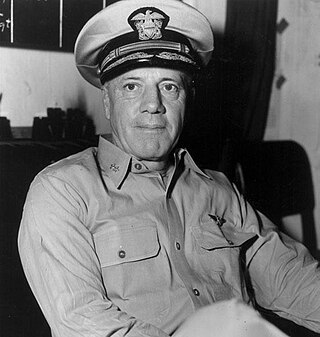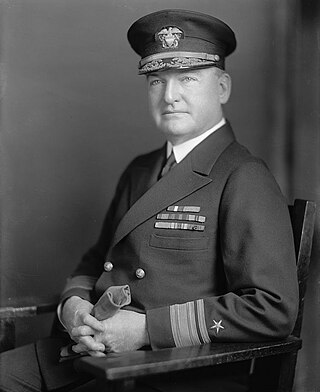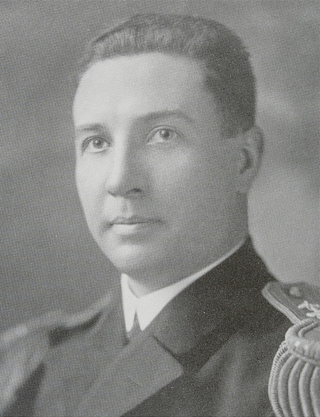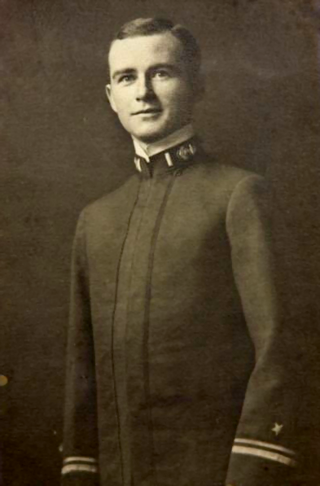
Rear Admiral Raymond Perry Rodgers was an officer in the United States Navy. He served as the second head of the Office of Naval Intelligence and as the 12th President of the Naval War College and fought in the Spanish–American War.
Raymond Stone was a United States Navy officer and Governor of Guam from January 28,1904 to May 16,1904. He served in multiple posts in the Navy,including aboard the battleship USS Kearsarge. He was stationed in Guam in the early 1900s,where he became aide to the governor. When William Elbridge Sewell was transported back to California with an intestinal disease,Stone became acting governor. He issued a series of orders limiting drug sale on the island and forcing vendors to lower prices on food and other essential items. After George Leland Dyer became governor,Stone became a judge on the Supreme Court of Guam before returning to the mainland. He would later serve as a liaison to the United States Army,where he oversaw the transfer of Naval prisoners of war from World War I to Army control.
George Leland Dyer was an American naval commander and the Governor of U.S. territory of Guam. In 1870,he graduated from the United States Naval Academy with honors and began his career in the United States Navy. During his career,he commanded the Stranger (1898),the Yankton (1898–1901),the Rainbow (1902–1903),and the Albany (1903–1904).

Charles Alan Pownall was a vice admiral in the United States Navy and Governor of Guam. He was the third military Governor and first naval Governor of Guam following the United States recapture of the island from the Japanese. After conflict with the Guam Congress in 1948,Pownall replaced many Congressmen with his own appointments,whom the Guamanians refused to recognize. The ensuing protest persuaded President Truman to transfer control of the island away from the Navy. As a consequence,Charles Pownall was the last military governor of Guam.
William Elbridge Sewell was a United States Navy Lieutenant Commander and the 6th Naval Governor of Guam from February 9,1903,until he returned to the mainland United States for medical treatment on January 11,1904. He was born in Colchester,New York,and appointed to the United States Naval Academy from that state in 1867. He served on numerous ships before becoming an ensign,and eventually became executive officer or commanding officer of a series of ships and installations. He then became commanding officer of the Guam flagship,and soon after,governor of Guam. As governor,he initiated a series of tax and legal reforms,including many that restored the rights of the native population to practice their culture more freely. He legalized and taxed alcohol and set up a court system that lasted 30 years. In January 1904,he fell ill from intestinal troubles and was transported to California for treatment,where he died while still in office.

Templin Morris Potts was a United States Navy Captain and the 11th Naval Governor of Guam. He held many important posts during his time in the Navy,including Director of the Office of Naval Intelligence,Naval attachéto Kaiser Wilhelm II,and aid for naval personnel. During the Spanish–American War,he participated in the Battle of Santiago de Cuba,after which he commanded a number of ships. In 1913,he was forced into retirement after not having spent a large enough portion of his service at sea. This forced retirement sparked outrage from many,and led to letters and marches of protest. A United States Senator even introduced a bill in Congress to have him re-instated. Though these efforts all ultimately failed,they led to greater scrutiny of the retirement board. As governor,he forbade the men under his command to marry native Chamorro women and increased funding to fight disease on Guam.

Luke McNamee was a United States Navy Admiral,businessman,and the 10th and 12th Naval Governor of Guam. He served in the navy for 42 years,during which time he held multiple commands. During the Spanish–American War,he earned the Navy Cross,and later the Legion of Honour.

Alfred Walton Hinds was a United States Navy captain who served as the 17th Naval Governor of Guam. His early naval service included serving as Assistant Engineer aboard USS Texas,the United States Navy's first battleship,where he was reprimanded for an accident aboard in 1896. In 1911,Hinds joined the staff of the United States Naval Academy,heading the Department of Marine Engineering and Naval Construction,writing a textbook on the subject while there.
Frank Barrows Freyer was a United States Navy captain who served as the 14th Naval Governor of Guam. Freyer graduated from the United States Naval Academy in 1902,having played several collegiate sports there. The Navy assigned him to many different ships,including having him participate in the Great White Fleet and its visit to Japan. Soon after,he was transferred to the Naval Base Guam,where he served as assistant to the Commandant before from November 5,1910,to January 21,1911,he became acting governor of the island. As governor,he suspended the licenses of all midwives on the island because of an alarming rate of infection,requiring them all to be re-certified. After George Salisbury relieved him of the position,Freyer became his aide.

William John Maxwell was a United States Navy officer who served as the 18th Naval Governor of Guam. He entered the United States Naval Academy in 1874,but was not commissioned as an ensign until 1883. He served aboard many ships before becoming one of the inaugural members of the General Board of the United States Navy. Afterward,he commanded both USS Mississippi and USS Florida.
William Adams Hodgman was a United States Navy captain and diplomat. He served on a number of ships,and briefly as the 23rd Naval Governor of Guam. During World War I,he commanded USS Roe,for which he received the Navy Cross. After leaving the navy,he served as commercial attachéto several countries,notably to Hungary,where he gained notoriety for striking a duke at a party.

Adelbert Althouse was a United States Navy Captain who served as the 27th and 29th Naval Governor of Guam. Prior to his Governorship,he served on ships in the Navy and participated in both the Spanish–American War and World War I. He earned the Navy Cross for his actions commanding USS Brooklyn and serving as Chief of Staff for the Commander and Chief of the United States Asiatic Fleet during the World War. As Governor,he focused on reforming the island's education system. He modeled a new system after that of co-educational California but also outlawed the speaking of the Chamorro language at schools in an effort to improve the English language skills of the local children. Most of his education reform took place in his first term.
Henry Bertrand Price was a United States Navy Captain who served as the 30th Naval Governor of Guam. As a naval officer,he served on many assignments,including with the Bureau of Ordnance. In 1913,he became executive officer of USS Delaware,and two years later commanding officer of USS Melville. Becoming governor in 1923,Price focused on agricultural development,particularly in the region of Mangilao,Guam. He also ordered increased road building and the establishment of the Guam Department of Agriculture.

Edmund Spence Root was a United States Navy Captain who served as the 34th Naval Governor of Guam. He graduated from the United States Naval Academy in 1905,serving on many ships as an ensign. He served as the inaugural commanding officer of two ships:USS Rizal and USS Astoria. He served during World War I as commander of the U-boat hunting USS Rowan,for which he received a letter of commendation. As governor,he generated controversy by expelling 112 Japanese laborers from Guam. The Guam Museum also opened during his term of office.

George Andrew Alexander was a United States Navy Captain who served as the 35th Naval Governor of Guam. Prior to serving as governor,he commanded USS Medusa. As Governor of Guam,he greatly changed the judicial system by purging the island of leftover Spanish laws and replacing them with the Code of Guam. He also led an unsuccessful campaign to obtain United States citizenship for all residents of Guam. After his term as governor,he commanded USS Arizona before retiring.

Franklin Jeremiah Drake was a Rear Admiral in the United States Navy. He fought in the American Civil War and the United States expedition to Korea.

George Johnson McMillin was a United States Navy rear admiral who served as the 38th and final naval governor of Guam. He served as an officer during four separate conflicts:World War I,the occupation of the Dominican Republic,the United States occupation of Veracruz,and World War II. He served on the staff of both the Naval Academy and the Naval War College as well. He is most remembered as the commander who surrendered Guamanian forces to a much larger Japanese force during the First Battle of Guam,only the second battle of World War II involving the United States. He had previously evacuated all but one civilian American citizen from the island and attempted to rebuild defenses after a strong typhoon devastated the island the year before. On December 8,1941,Japanese forces invaded Guam and McMillin surrendered two days later. He spent the rest of the war at various Japanese prisoner of war camps.

William Pigott Cronan was a United States Navy captain who served as the 19th Naval Governor of Guam. During his tenure in the Navy,he became decorated,commanded a number of ships,and came to be known as "the most popular man in the Navy". He participated in the Battle of Santiago de Cuba during the Spanish–American War. In 1903,he gained some attention for his participation in the rescue of a Venezuelan fisherman off the coast of La Guaira under bad conditions. Both the Venezuelan government and navy command praised him for the way he carried out the operation. He became a national news story in 1907 while serving aboard USS Connecticut during a training operation. When a gun nearly exploded because of leaking powder;he shoved his hand into the gun's breechblock,preventing the explosion and losing two of his fingers in the process.
Ivan Cyrus Wettengel was a United States Navy captain who served as the 25th Naval Governor of Guam. A graduate of the United States Naval Academy,Wettengel commanded a number of ships. He received the Navy Cross for his command of USS Wisconsin during World War I. He also commanded USS Texas and the Naval Training Station Hampton Roads. During his tenure as governor,he overturned many of the unpopular policies of William Gilmer. He also attempted to assemble a bull-mounted Guam Cavalry,but the initiative failed. A number of locations in Guam are named in his honor.

Rear Admiral Frederick W. Rodgers was an officer in the United States Navy. He fought in the American Civil War and rose to be the last commander of the Asiatic Squadron. He was a grandson of U.S. Navy Commodore Matthew C. Perry.













